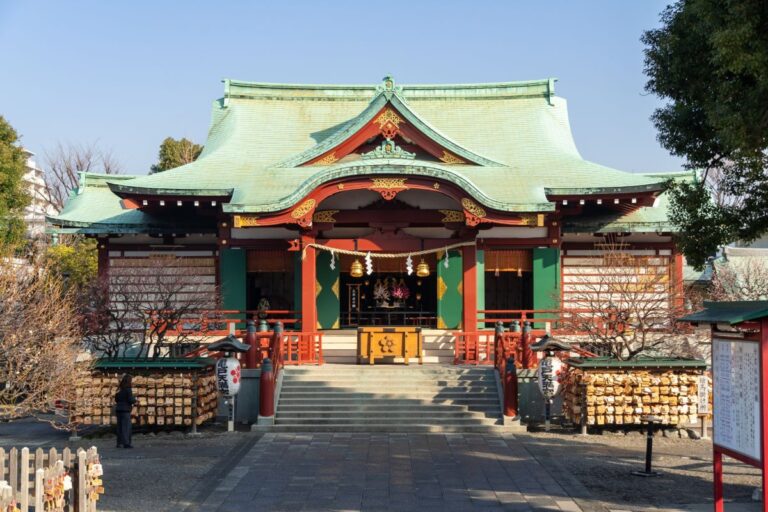Nestled next to Yoyogi Park in Tokyo’s Shibuya, Meiji Jingu is a Shinto shrine dedicated to the deified spirits of Emperor Meiji and his wife, Empress Shoken. It is one of the most popular and revered shrines in Japan, attracting over 3 million visitors during the first few days of the New Year alone.
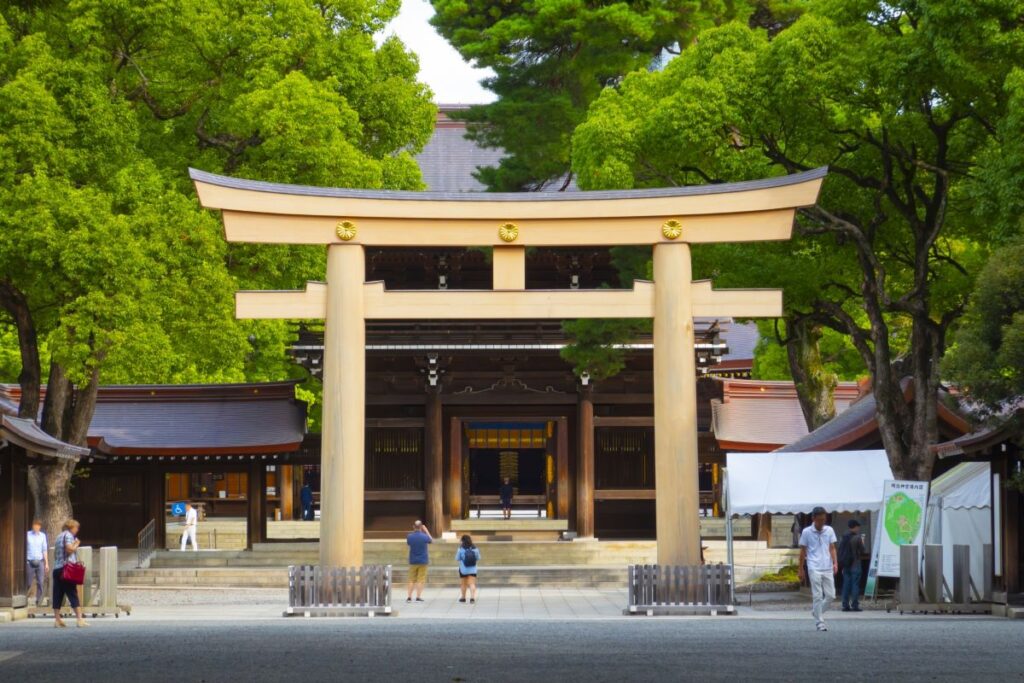
As you approach the shrine, you’ll be greeted by towering torii gates and a serene forested area. The shrine’s grounds cover over 170 acres and include a treasure museum, a garden, and other buildings. The main hall, or honden, is a beautiful example of Shinto architecture, with a thatched roof and intricate carvings.
The shrine’s serene atmosphere and beautiful architecture make it a popular destination for both tourists and Tokyoites.
History
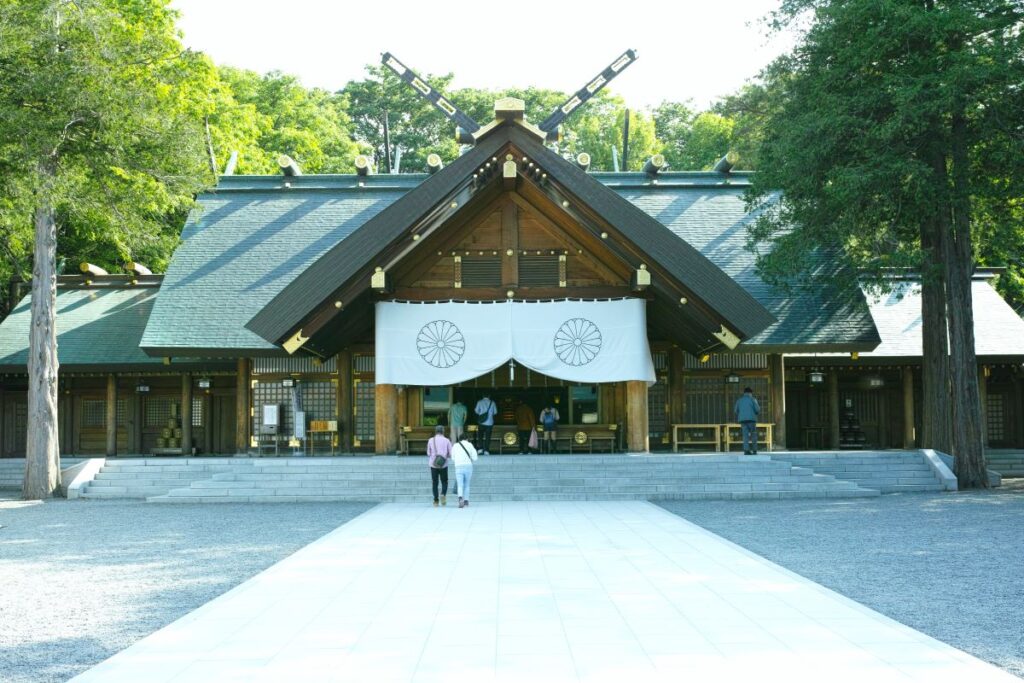
This shrine was built in 1920 to honor the spirits of Emperor Meiji and his wife, Empress Shoken. Emperor Meiji is well-known for his role in modernizing Japan and bringing it into the modern era. He ascended to the throne in 1867, at the age of just 15, and ruled for over 40 years. During his reign, Japan underwent a period of rapid modernization and industrialization, which helped make it the economic powerhouse it is today.
Emperor Meiji was also responsible for introducing many Western customs and practices to Japan, including the adoption of a new calendar, the establishment of a national education system, and the introduction of a new legal code. He was also a strong supporter of the arts, and helped to promote traditional Japanese culture both at home and abroad.

After Emperor Meiji’s death in 1912, the Japanese government began planning a shrine to honor his memory. The shrine was completed in 1920, and has since become one of the most popular tourist attractions in Tokyo. The shrine is in a large forested area in the heart of the city, and is surrounded by beautiful gardens and walking trails.
Today, Meiji Jingu Shrine is not only a place of worship but also a symbol of Japan’s rich cultural heritage.
Architecture
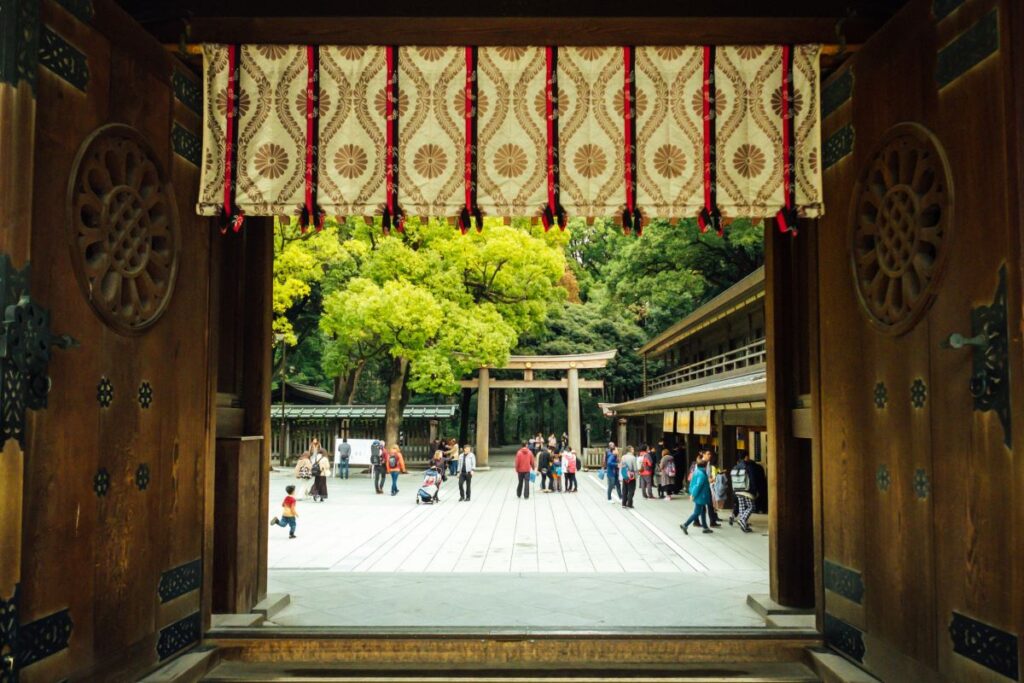
As you approach the Meiji Jingu Shrine, you will notice the impressive Torii gate, which stands 12 meters tall and is made of 1,500-year-old cypress trees. The shrine itself is a stunning example of traditional Japanese architecture, featuring a nagare-zukuri style with a thatched roof made of copper plates. The use of Japanese cypress in the construction of the shrine not only adds to its aesthetic appeal but also gives you durability against the elements.
One of the most unique features of the Meiji Jingu Shrine is that it was built without the use of a single nail. Instead, the wooden beams were interlocked using a traditional Japanese joinery technique called “kigumi. This technique involves interlocking wooden pieces without the use of metal hardware, creating a strong and sturdy structure that can withstand earthquakes and other natural disasters.

Inside the shrine, you will find a spacious hall with a high ceiling and wooden pillars adorned with intricate carvings. The hall is designed to allow natural light to filter in, creating a serene and peaceful atmosphere. The shrine also features a treasure house that displays artifacts related to Emperor Meiji and Empress Shoken.
If you’re interested in learning more about the architecture of the Meiji Jingu Shrine, be sure to visit the adjacent Meiji Jingu Museum. Designed by renowned architect Kengo Kuma, the museum features a modern interpretation of traditional Japanese architecture and showcases exhibits related to the Meiji era.
Gardens

If you’re looking for a peaceful escape from the bustling city then make a beeline for Meiji Jingu’s Inner Gardens. They span over 83,000 square meters and offer a serene atmosphere with flora and fauna.
The gardens were once Imperial Property and were commissioned by Emperor Meiji for Empress Shoken. The gardens feature traditional Japanese landscaping, including a pond, a tea house, and a rock garden.
One of the highlights of the gardens is the Azalea Hill, which boasts over 3,000 azalea bushes that bloom in the spring. The hill gives you a stunning view of the gardens and the surrounding cityscape.
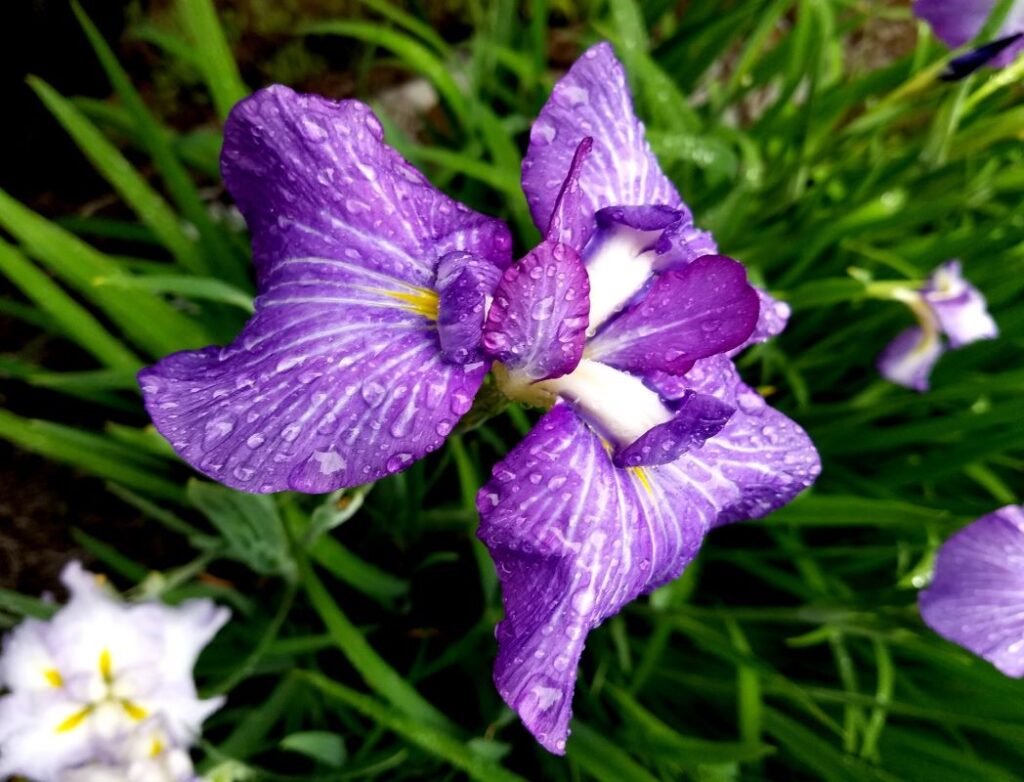
Another must-see is the Kiyomasa’s Well, a historic well named after a samurai who once lived on the site. The well is believed to have healing properties and is a popular spot for visitors to take a sip of the water. If you’re interested in Japanese art, be sure to visit the Kaku-un-tei, a tea house that was once owned by a famous calligrapher.
The tea house features beautiful calligraphy and traditional Japanese paintings. Overall, the Inner Gardens of Meiji Jingu offer a peaceful and beautiful respite from the city. It’s a great place to relax and take in the natural beauty of Japan.
Festivals and Events

Meiji Jingu Shrine is not only a place of worship but also a hub of cultural activities. Throughout the year, the shrine hosts festivals and events that attract visitors from all over the world. Here’s a few of the most popular festivals and events at Meiji Jingu Shrine:
- Spring Festival: Held on May 2nd and 3rd, this festival is one of the biggest events at Meiji Jingu Shrine. It features traditional music and dance performances, as well as food stalls selling local delicacies.
- Autumn Festival: This festival takes place from November 1st to 3rd and is another major event at Meiji Jingu Shrine. It celebrates the birthday of Emperor Meiji and includes parades, martial arts demonstrations, and traditional Japanese dance performances.
- New Year’s Day Ceremony: On January 1st, Meiji Jingu Shrine holds a special ceremony to mark the beginning of the new year. You can witness the shrine’s priests offering prayers and blessings for the year ahead.
- Emperor Meiji Memorial Festival: Held on July 30th, this festival commemorates the death of Emperor Meiji, who played a key role in modernizing Japan. It features traditional music and dance performances, as well as exhibitions on the life and legacy of the emperor.
Visiting Meiji Jingu Shrine
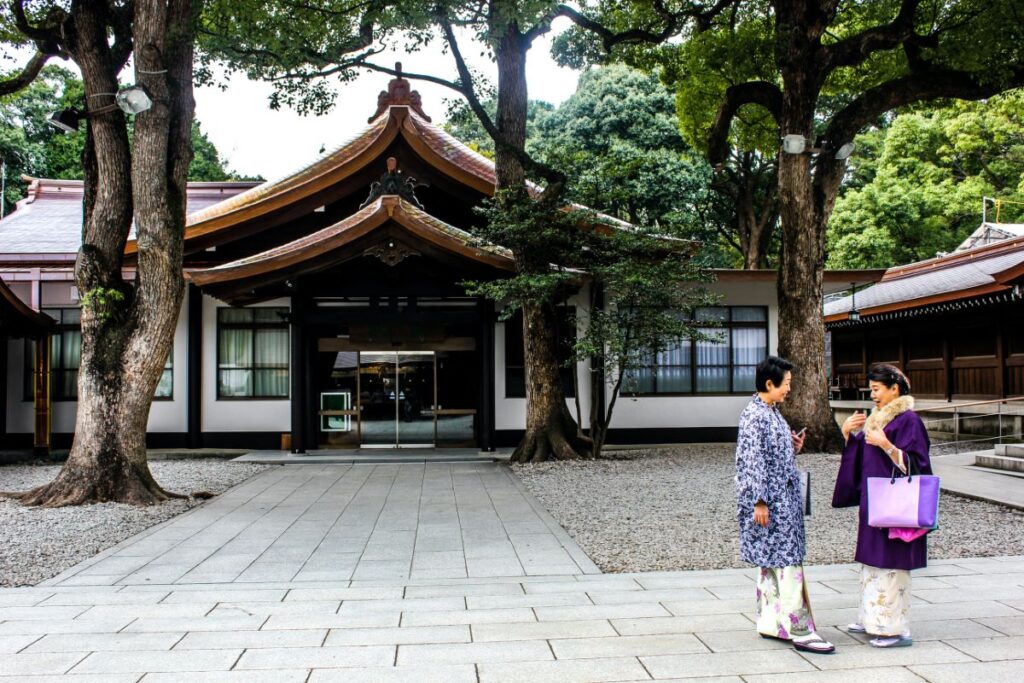
To get to the shrine, take the Yamanote Line to Harajuku Station or the Chiyoda or Fukutoshin lines to Meiji-jingumae Station. From there, it’s just a 10-minute walk to the shrine.
Meiji Jingu is open every day of the year, with free admission. The shrine opens at sunrise and closes at sunset, but some facilities inside the shrine may have shorter opening hours, usually from 9:00 am to 4:00 pm. While at the shrine, you can witness traditional Shinto weddings taking place, and you may even be lucky enough to see a traditional Japanese wedding procession.
You can also purchase ema, small wooden plaques to write your wishes on and hang at the shrine. Be sure to also visit the Meiji Jingu Treasure House, where you can see the personal belongings of Emperor Meiji and Empress Shoken, including their wedding carriage and clothing. Overall, visiting Meiji Jingu Shrine is a peaceful and spiritual experience that should not be missed during your trip to Tokyo.
Hatsumode (New Years Guide)

The historic Meiji Jingu Shrine in Yoyogi-Kamizonocho, Shibuya-ku, is the most visited shrine for Hatsumode every year in Japan and can be said to be the most famous shrine in Japan.
<.-- /wp:paragraph -->
<.-- wp:image {"id":35305,"sizeSlug":"large","linkDestination":"none"} -->
<.-- /wp:image -->
<.-- wp:paragraph -->
It is also known as a place where prestigious events such as the yokozuna ring-entering ceremony of sumo wrestlers are held.
<.-- /wp:paragraph -->
<.-- wp:paragraph -->
The shrine was built in 1920. The torii gate is the largest Myojin torii in Japan and is made of a 1,500-year-old Japanese cypress tree.
<.-- /wp:paragraph -->
<.-- wp:image {"id":35302,"sizeSlug":"large","linkDestination":"none"} -->
<.-- /wp:image -->
<.-- wp:paragraph -->
The shrine is dedicated to Emperor Meiji and Empress Dowager Shoken. The deity’s virtues include world peace, domestic safety, physical safety, exorcism of bad luck, prayer for success in school, the prosperity of the company’s fortunes, and prosperity of business.
<.-- /wp:paragraph -->
<.-- wp:image {"id":35304,"sizeSlug":"large","linkDestination":"none"} -->
<.-- /wp:image -->
<.-- wp:paragraph -->
During the New Year’s Hatsumode, a New Year’s Day ceremony is held to pray for the prosperity of the imperial family and the nation. New Year’s New Year prayers are also held which sees about 3.2 million people visit the shrine.
<.-- /wp:paragraph -->
<.-- wp:paragraph --><.-- /wp:paragraph -->
<.-- wp:paragraph --><.-- /wp:paragraph -->
<.-- wp:image {"id":35306,"sizeSlug":"large","linkDestination":"none"} -->
<.-- /wp:image -->
<.-- wp:paragraph -->
Parking for about 50 cars is available, but it is not available on New Year’s 3rd and the surrounding area is crowded with the most worshippers in Japan, so it is best to use public transportation.
<.-- /wp:paragraph -->
<.-- wp:paragraph -->
The expansive Yoyogi Park, and Meiji Jingu Gaien are nearby.
<.-- /wp:paragraph -->
<.-- wp:image {"align":"none","id":27881,"className":"wp-image-27881 size-full"} -->
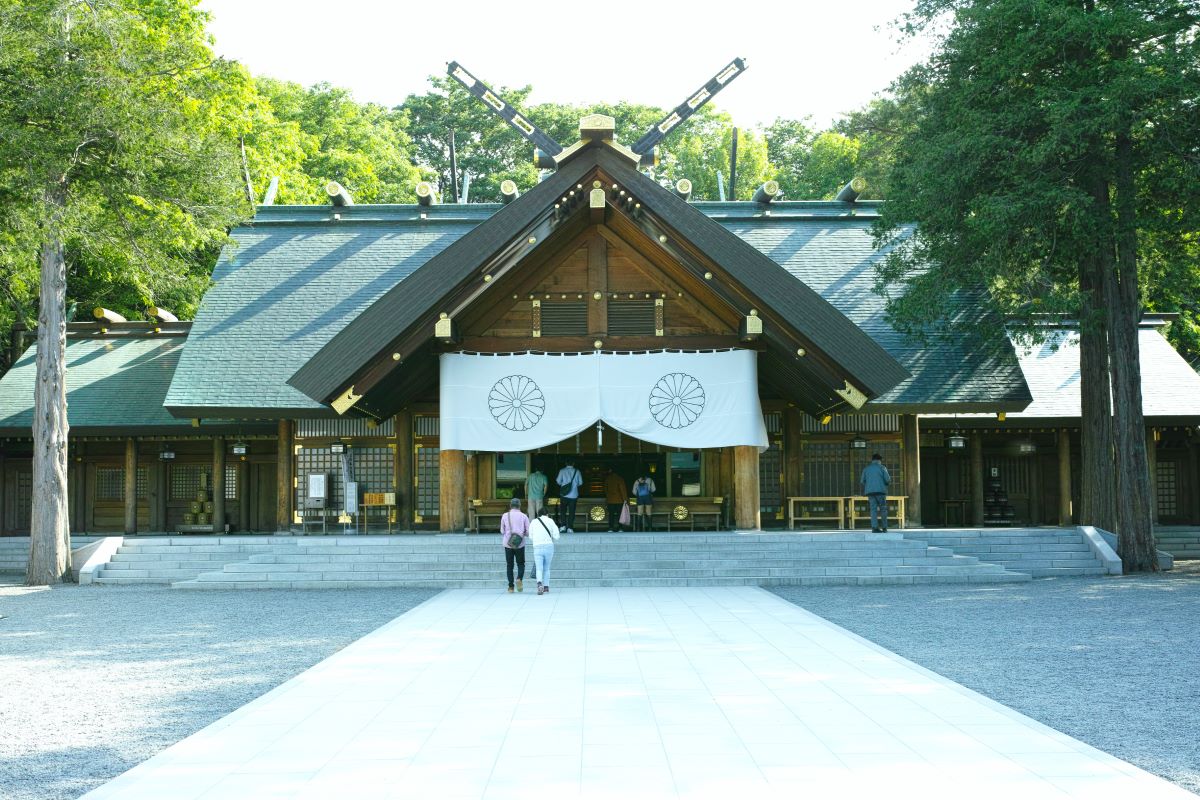
<.-- /wp:image -->
<.-- wp:table -->
| Name | Meiji Jingu Shrine 明治神宮 |
|---|---|
| Hours | Sunrise to Sunset |
| Closed | without a holiday |
| Fee | free |
| Address | 1-1 Yoyogi-Kamizonocho, Shibuya-ku, Tokyo |
| Telephone | 03-3379-5511 |
<.-- /wp:table -->
<.-- wp:image {"id":35307,"sizeSlug":"full","linkDestination":"none"} -->

<.-- /wp:image -->
<.-- wp:heading -->
How To Get To The Meiji Jingu Shrine
<.-- /wp:heading -->
<.-- wp:list -->
- <.-- wp:list-item -->
- 1 minute walk from Omotesando exit of Harajuku station on Yamanote line
- Or Meiji-jingumae station on Chiyoda line.
<.-- /wp:list-item -->
<.-- wp:list-item -->
<.-- /wp:list-item -->
<.-- /wp:list -->
<.-- wp:kadence/googlemaps {"uniqueID":"_1a4e79-7c","location":"Meiji Jingu Shrine"} -->
<.-- /wp:kadence/googlemaps -->
Where To Stay In Tokyo
Tokyo visitor levels are currently at an all-time high so make sure to book your hotels early. Tip most hotels booked with booking.com have free cancelation so book as soon as you know your date and you can always cancel if you change your mind.





